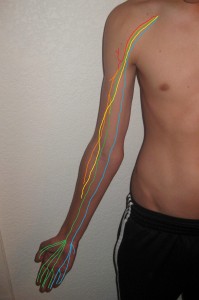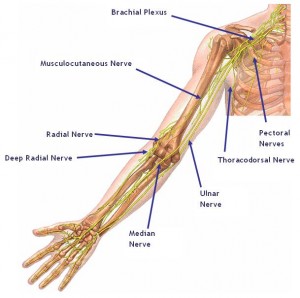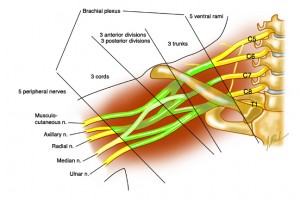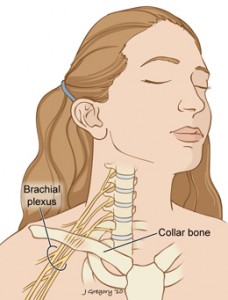The brachial plexus in a gathering of nerves that come out of the the neck and ultimately travel down the arm. Our central nervous system is comprised of the brain and spinal cord and the peripheral nervous system is the nerves that come through the spine making their way to the rest of the body.
There are a number of sections of nerve pathways known as plexuses where a network of nerves join after leaving the spine to form a new series of nerves before heading into the trunk and extremities.
The brachial plexus is a group of nerve fibers that emanate from the spinal cord near its top, coming through the lower four cervical vertebrae (C5-8) and the uppermost thoracic vertebra (T1).
The brachial plexus is divided into Roots, Trunks, Divisions, Cords, and Branches.
These nerve roots, as you can see in the pictures above, pass through the neck and shoulder ultimately becoming the branches that control the hand, wrist, elbow, and upper arm.
The branches of the brachial plexus are the musculocutaneous, radial, axillary, median, and ulnar nerves that innervate the arm.
The median and ulnar nerves travel down into the hand with the other three coming to an end point higher up.
The nerves of the brachial plexus are particularly susceptible to postural issues and muscle imbalances because any misalignment in the head neck and shoulders can easily affect the brachial plexus and the free flow of nervous energy to the arm.
Forward head posture that misaligns the shoulder girdle altering the harmonious relationship of the upper ribs and the collar bone can easily cause compression in the brachial plexus.
Tight muscles such as pectoralis minor and teres major among others can have a similar inhibiting effect on the passageway of these nerves.
Building too much muscle, particularly in the case of the biceps can also have a negative impact on these nerves.
There are many reasons to improve our posture but the main one is all about creating the best possible path for our nerves to follow.
I’ll cover the median nerve of carpal tunnel syndrome in a post of its own in the next few days.
***




